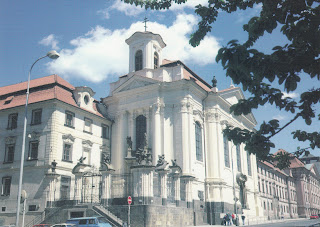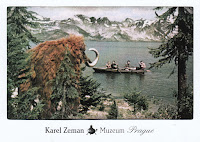Over the weekend I was in Prague.
Prague was until 1992 the capital of Czechoslovakia and is today the capital of the Czech Republic. It is also the largest city of its country and the 14th largest of the European Union. Although the city is known for its problem with pickpockets, it is one of the most visited cities in Europe. The Historic Centre of Prague is since 1992 on the UNESCO World Heritage List.
Wenceslas Square is the centre of the business and cultural communities in Prague's New Town. It is one of the largest city squares in Europe and a traditional setting for demonstrations. Located on the upper end of Wenceslas Square is the main building of the Czech National Museum.
Prague Castle is the largest castle in the World. It was founded in the 9th century and since then various architects of various architectural styles contributed to the appearance of the castle. For centuries it was the seat of the Kings of Bohemia, two Holy Roman Emperors and the Presidents of Czechoslovakia. Today it is the seat of the Czech President and a popular destination for tourists.
The Saint Vitus Cathedral was built between 1344 and 1929 within the Prague Castle. It is an excellent example of Gothic architecture and is the biggest and most important church in the Czech Republic. The cathedral is the seat of the Archbishop of Prague, but since the Communist Era it is not owned anymore by the Catholic Church but by the Czech government. One of the cathedral's windows was designed by Alfons Mucha and located within it is the tomb of Emperor Charles IV. Also the Czech Crown Jewels are housed in the cathedral.
Also located on the Prague Castle is a post office with a philatelic counter. Two of the collectibles I bought there are a souvenir sheet about the Centenary of World War I (issued 14-10-2015) and a FDC about Fairy Amálka (issued 18-05-2016).
You can see the other things I bought in the post office on my Stamp Blog.
Wallenstein Palace is the first monumental secular Baroque building in Prague. Its construction was commissioned by Albrecht von Wallenstein in the 17th century. It remained in the Wallenstein family until 1945, but after World War II the palace became Czechoslovak state property. Today it houses the Czech Senate.
The Charles Bridge connects the Old Town and Malá Strana. The construction started in 1357 and in the 17th century the famous Baroque statues and statuaries were added. For centuries it was Prague's only bridge over the Vltava River. It is today the most visited place in the city.
Located on the southern wall of Prague's Old Town Hall is the Astronomical Clock. It is said to be a masterpiece of the Gothic era. First installed in 1410 it is the third-oldest astronomical clock in the World and the oldest one, which is still operating.
The Church of Our Lady before Týn is a real gem of the Bohemian Gothic. It was built in the 14th century.
Between the 13th century and 1848 the Jews of Prague were forced to live within their own quarter, which is now known as Josefov. The quarter started to decay after the rich Jews left their former ghetto. At the end of the 19th century many old buildings were destroyed to create space for a reconstruction. Only six synagogues, the town hall and the Jewish Cemetery survived this period. During World War II the most Jews were killed by the Nazis, but the buildings were kept, because there were plans to create a "Museum of the Eradicated Race" in Prague. 1950 the buildings were placed under the control of the Czech Government, which started to operate a real Jewish Museum. Today the Jewish community of Prague has again the control over its heritage.
The Old New Synagogue was completed in 1270. It is one of Prague's first gothic buildings and Europe's oldest active synagogue. According to the legend Rabbi Loew created the Golem at the Old New Synagogue in the 16th century.
The Old Jewish Cemetery is the largest Jewish cemetery in Europe. Renowned personalities of Prague's Jewish community were buried there including Rabbi Loew and businessman Mordecai Maisel. It was in use between the 15th century and 1786 and there are places where as many as twelve layers exist now, because the Jews do not abolish old graves and the space for the cemetery was limited.
The Spanish Synagogue is the newest synagogue in Josefov. It was built in the Moorish Revival Style.
Franz Kafka was born into a German-speaking Jewish family in Prague in 1883. He is considered to be one of the most important writers of the 20th century and combines elements of realism and the fantastic in his writings. His best known works include "The Metamorphosis" and "The Trial". He died in 1924.
In 2003 a statue of Franz Kafka was installed in Prague. It was designed by Jaroslav Róna and is based on Kafka's first novel, "Amerika".
The Saints Cyril and Methodius Cathedral was built between 1730 and 1736. It is the principal church of the Czech and Slovak Orthodox Church. In 1942 the church was stormed by Nazi troops, because the assassins of Nazi SS Obergruppenführer Reinhard Heydrich were hidden in the church's crypt. The church crypt now houses a museum.
The Dancing House was designed by the Croatian-Czech architect Vlado Milunić in cooperation with Canadian-American architect Frank Gehry. It was completed in 1996 and houses an art gallery, a hotel, offices, a restaurant and a bar.
The Karel Zeman Museum was opened in 2012. Its interactive exhibition presents the life's work of Czech film director Karel Zeman and his cinematic tricks.
Karlštejn Castle is located about 30 kilometres southwest of Prague. It was founded in 1348 by Emperor Charles IV. The castle served as a place for safekeeping the Imperial Regalia between 1350 and 1421. Today it is one of the most visited castles in the Czech Republic.
I also bought four postcards about Czech Cartoons.








































No comments:
Post a Comment